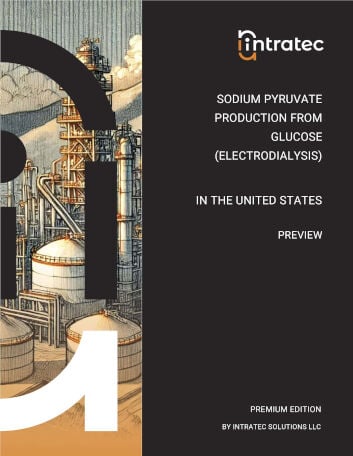Commodity Production Costs Report
Sodium Pyruvate Production from Glucose (Electrodialysis)
Sodium Pyruvate Plant Capital & Operating Cost Analysis | United States | Q3 2025
This report presents the economics of Sodium Pyruvate production from glucose. The process examined is a typical fermentation process. In this process, the fermentation product is pyruvic acid, which is recovered from fermentation broth using electrodialysis. The obtained pyruvic acid is contacted with sodium hydroxide, forming Sodium Pyruvate product.
The report provides a comprehensive study of Sodium Pyruvate production and related Sodium Pyruvate production cost, covering three key aspects: a complete description of the Sodium Pyruvate production process examined; an in-depth analysis of the related Sodium Pyruvate plant capital cost (Capex); and an evaluation of the respective Sodium Pyruvate plant operating costs (Opex).
The Sodium Pyruvate production process description includes a block flow diagram (BFD), an overview of the industrial site installations, detailing both the process unit and the necessary infrastructure, process consumption figures and comprehensive process flow diagrams (PFD). The Sodium Pyruvate plant capital cost analysis breaks down the Capex by plant cost (i.e., ISBL, OSBL and Contingency); owner's cost; working capital; and costs incurred during industrial plant commissioning and start-up. The Sodium Pyruvate plant operating costs analysis covers operating expenses, including variable costs like raw materials and utilities, and fixed costs such as maintenance, labor, and depreciation.

Product
Sodium Pyruvate. Sodium Pyruvate is a salt of the conjugate anion form of pyruvic acid, known as pyruvate. This acid is the simplest alpha-keto acid, with a carboxylic and a ketone functional group. Pyruvate is an important chemical compound in biochemistry, being the output of the glucose metabolism, and is then converted into acetyl-coenzime A, the main input of the Krebs cycle. It is commonly used in cell culture media, as a carbon source in addition to glucose. Pyruvic acid is colorless liquid, soluble in water, with a smell similar to acetic acid. It can be inorganically produced by heating a mixture of tartaric acid and potassium hydrogen sulfate, oxidation of propylene glycol by a strong oxidizer, or by the hydrolysis of acetyl cyanide.
Raw Material
Glucose Syrup. Glucose (C6H12O6), also known as D-glucose and dextrose, is the most abundant sugar in nature. Commercial glucose products are available in both dry and syrup forms in a variety of purities and concentrations. Glucose uses include pharmaceuticals, food, chemicals and fuels. This compound is used as raw material in fermentative processes for the production of vitamins, organic acids, antibiotics, amino acids, enzymes, and polysaccharides.
Report in PDF Format
Download & Explore Anytime
Access in Various Devices
Print & Read Comfortably
Share With Co-workers
Up-to-date Report
Professional report based on Q3 2025 economic data, ensuring timely evaluations.
Multiple Use Cases
Ideal for investment screening, feasibility studies, cost estimates, and research planning.
Proven Methodology
Developed using a consistent methodology honed over a decade, ensuring reliable cost analyses.
Report Editions
Content Highlights
Plant Capital Cost Summary
Summary outlining the capital cost required for building the Sodium Pyruvate production plant examined.
Plant Capital Cost Details
Detailing of fixed capital (ISBL, OSBL & Owner’s Cost), working capital and additional capital requirements.
Plant Cost Breakdowns
Breakdown of Sodium Pyruvate process unit (ISBL) costs and infrastructure (OSBL) costs; plant cost breakdown per discipline.
Operating Costs Summary
Summary presenting the operating variable costs and the total operating cost of the Sodium Pyruvate production plant studied.
Operating Cost Details
Detailing of utilities costs, operating fixed costs and depreciation.
Plant Capacity Assessment
Comparative analysis of capital investment and operating costs for different Sodium Pyruvate plant capacities.
Production Process Information
Block Flow Diagram, descriptions of process unit (ISBL) and site infrastructure (OSBL).
Process Consumptions
Raw materials and utilities consumption figures, by-products credits, labor requirements
Process Diagrams
Process flow diagrams (PFD), equipment list and industrial site configuration
Other Sodium Pyruvate Production Cost Reports

Sodium Pyruvate Production from Glucose (Solvent Extraction)
This report analyses the economics of Sodium Pyruvate production from glucose in the United States. In this process, glucose is fermented to pyruvic acid, which is recovered from fermentation broth using solvent extraction. The solution containing pyruvic acid is contacted with sodium hydroxide, forming Sodium Pyruvate.
Details: 2 kta United States-based plant | Q3 2025 | 107 pages | Issue A | From $1,999 USD
Bundle & Save
Purchase multiple Sodium Pyruvate Production Cost reports and enjoy tiered discounts
up to 10% off!
Could Not Find the Report You Need?
Obtain a Bespoke Report
Get a report targeting the process in which you are interested
See Offer Details
Understand Bespoke Reports and how you can easily order them
Check Editions & Pricing
Complete a brief form and see a quotation for your Bespoke Report
Other Related Production Cost Reports

Glucose Syrup Production
This report presents the economics of Glucose Syrup production from shelled corn. In this process, shelled corn is passed through a wet milling process to recover the corn starch, which, in turn, passes through two subsequent hydrolysis steps for the generation of glucose. The economic analysis performed assumes a plant located in the United States.
Details: 40 kta United States-based plant | Q3 2025 | 107 pages | Issue A | From $799 USD
+800 Reports Developed, Targeting +250 Commodities
Vast Report Library
858 independent and up-to-date reports examining embryonic and established production processes.
Free Sample Reports
Quickly understand the structure and depth of content of our professional reports.

